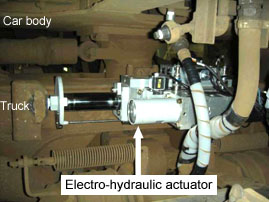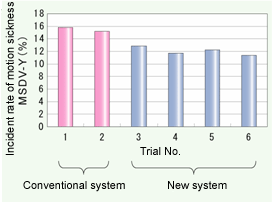|
To improve the performance and ride comfort of controlled tilting cars, the RTRI developed a new-generation tilting car control system using an innovated position-detecting method, featuring the three element technologies of position detection, a tilting pattern and a tilting actuator.
The position-detecting method uses a global positioning system (GPS) signal, and combines the advantages of curvature reference and cumulative wheel rotational frequency from the signal for high-precision determination of running position in tunnels and other places.
The tilting pattern gives the targeted value of car inclination, known as the judgment function, with a TCT (JT) pattern in contrast to the existing CA mode. It is calculated to optimize the ride comfort index based on running speed and measured track data (i.e. curvature and cant).
The electro-hydraulic tilting actuator used to tilt the car body correctly according to the JT pattern, features a monolithic structure consisting of cylinder, motor, pump, valve and other components, with only electric wires extending outside. In the state of natural pendulum with tilting not controlled, it functions as a tilting damper. Figure 1 shows its appearance when installed on a truck.
In a questionnaire survey carried out during a running test, its ride comfort was evaluated to be superior to that of the conventional system. It was also confirmed that the incident rate of motion sickness was two points lower than before due to the decreased low-frequency lateral vibration. This verified the effectiveness of the system (Fig. 2).

Fig. 1 Installation of an electro-hydraulic actuator on a truck
|

Fig. 2 Comparison of the incident rates of motion sickness between the conventional and new systems |
HOME > Major Results of Research and Development in Fiscal 2004 > III Rapidity/Convenience

RTRI HOME
Copyright(c) 2005 Railway Technical Research Institute,Tokyo Japan, All rights reserved.
|

